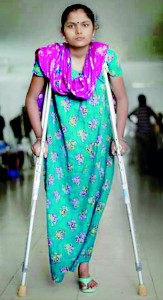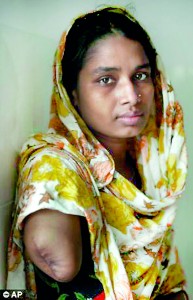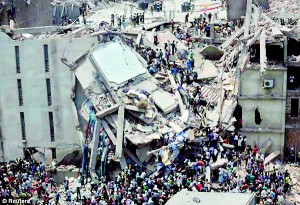Sunday Times 2
Baring their scars: Survivors of Bangladesh’s factory collapse
As they lay for hours trapped in the rubble, these women felt a surge of hope when rescuers eventually found them.
But incredibly the worst was yet to come – in the desperate bid to free the garment workers, rescuers with no medical training were forced to perform amputations on the spot to free them without anaesthetic.
They were heard screaming in agony as some of the rescuers used butchers knives or hacksaws to cut through the flesh and save the trapped workers.
When the Rana Plaza factory building crashed down in April, 1,129 people were killed.
 |
 |
| Trapped: Sonia, 18, left,
who worked on the 6th floor of Rana Plaza had her right leg amputated to free her from the rubble when she was rescued nearly 48 hours after the building collapsed. Rikta, 27, right, had her right arm amputated inside the rubble when she was rescued nearly 72 hours after the building collapsed. |
|
Many of those freed are still recovering.
Laboni, 21, worked on the fourth floor.
Her left arm was amputated to free her from the rubble, 36 hours after the building collapsed.
Shahi Noor, 25, worked on the sixth floor – her right leg was cut off to free her on the day of the collapse.
Bangladeshi garment worker Mariyam, 30, worked on the 6th floor of Rana Plaza.
She had her right arm amputated to free her from the rubble when she was rescued nearly 72 hours after the building collapsed
Bangladesh’s government and garment manufacturers are campaigning to close dangerous factories and to make safety a priority for the country’s most valuable export industry.
But many in the government, the industry and the rescue workers said they would not be shocked if another terrible tragedy happened.
In the wake of the Rana Plaza disaster, the country was under extreme pressure from Western brands to improve safety and Bangladesh’s government and garment manufacturers are campaigning to close dangerous factories and to make safety a priority for the country’s most valuable export industry.
Swedish retailer H&M, PVH, the parent company of Calvin Klein, and Inditex, which owns Zara, are among companies that signed an agreement to help finance safety improvements in Bangladesh factories. Wal-Mart and the Gap have not.
Bangladeshi garment factories are routinely built without consulting engineers.
Many are located in commercial or residential buildings not designed to withstand the stress of heavy manufacturing.
Some add illegal extra floors atop support columns too weak to hold them, according to a survey of scores of factories by an engineering university that was shown to The Associated Press.
A separate inspection, by the garment industry, of 200 risky factories found that 10 percent of them were so dangerous that they were ordered to shut.
 The textiles minister said a third inspection, conducted by the government, could show that as many as 300 factories were unsafe.
The textiles minister said a third inspection, conducted by the government, could show that as many as 300 factories were unsafe.
Taken together, the findings offer the first broad look at just how unsafe the working conditions are for the garment workers who produce clothing for major western brands.
And it’s more bad news for the $20 billion industry that has been struggling to regain the confidence of Western retailers and consumers following a November fire at the Tazreen Fashions Ltd. factory that killed 112 people and the April collapse of the Rana Plaza building.
But the proliferation of inspections could signal the industry is finally taking its workers’ safety seriously.
Rana Plaza was ‘a wakeup call for everybody ‘to ensure their buildings were structurally sound, said Shahidullah Azim, vice president of the Bangladesh Garment Manufacturers and Exporters Association.
‘Earlier it was not in our minds. We never, ever thought of this,’ he said.But Rana Plaza wasn’t the first factory building to collapse in Bangladesh.
In 2005, the Spectrum sweater factory crumbled on top of workers, killing 64.
That building was also found to have illegal additions.
© Daily Mail, London
Follow @timesonlinelk
comments powered by Disqus

